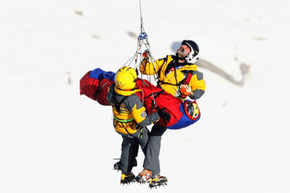A trio of snowboarders slide up to a steep drop-off at a desolate section of a Colorado mountain and notice a sign that reads "DANGER: NO RECREATIONAL ACTIVITY BEYOND THIS POINT." They look at each other, fist bump and take off over the edge anyway. Hours later a rescue helicopter arrives to pick up the snowboarders who are struggling to survive in various stages of frostbite and injury.
This scenario has become more common in recent years as adventurers seek to outdo one another. And it's not just skiers and snowboarders. It's climbers, hikers, campers, boaters, scuba divers, kayakers and even bird watchers. If there is an activity that involves the great outdoors, then there's a potential for danger, accident and ultimately a need for rescue.
Advertisement
When it comes to search and rescue (SAR), the debate over who should foot the bill has reached a fever pitch. Every time a high profile rescue is performed because an outdoor enthusiast acted recklessly or maybe even illegally, the news media is rife with commentary over the cost associated with the operation. In years past, these rescues didn't get as much attention, but as expenses have grown, it's become a hot topic that can't be ignored. It also has something to do with the nature of the "extreme" athlete. The mountain face can never be high enough; the ski run can never be steep enough. These thrill-seekers look for ground that no one else dares to tread, and this kind of recreation comes with inherent dangers.
The cost of rescue operations varies wildly depending on the scenario. Who ultimately pays depends on what agencies are involved in the rescue, where it takes place and the circumstances that put the victim into harm's way to begin with. We'll look at the different policies regarding the cost of SAR on the following page.
Advertisement


